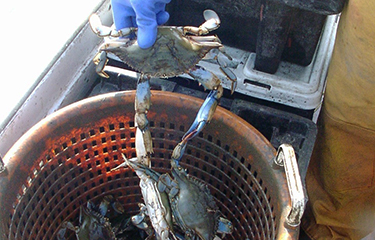New crab fishing restrictions have been put in place for the Chesapeake Bay in the U.S. Mid-Atlantic after surveys found that the bay’s crab population is at an historic low.
Results from a bay-wide blue crab dredge survey showed a continued downturn in juvenile crab recruitment and a record low year of total blue crab abundance. The total abundance declined from 282 million in 2021 to 227 million crabs in 2022. That’s the lowest abundance estimate in the 33-year history of the winter dredge survey. The last all-time high of 852 million crabs was reported in 1993.
Those findings led the Virginia Marine Resources Commission (VMRC), and Maryland’s Department of Natural Resources (DNR) to place restrictions on crabbers, cutting down on days they can work and on catch limits.
Those restrictions, in turn, drove up the prices consumers pay for crabs and have squeezed fishermen who are already facing inflation and higher fuel costs.
Maryland DNR’s blue crab industry advisory committee voted 16 June, 2022, to accept harvest cutbacks of up to 29 percent from 2021 catch limits in their daily allowable catch of female crabs, depending on the month and the amount or type of gear a watermen is licensed to use. The committee also agreed to first-ever limits on harvests of male crabs from August through September. The daily cap would range from four bushels to 15 or 16 bushels, depending on gear and license type. The catch restrictions would be greatest in late summer and early fall when the current crop of juvenile crabs begins to reach legally catchable size.
The Virginia MRC unanimously agreed on 29 June to impose new restrictions on commercial harvests from 1 October to the end of the season on 30 November. Those reduced limits will carry over for six weeks into the start of the 2023 season, four weeks longer than originally planned. The crab pot season will be the same this year and next, but VMRC plans to make seasons on all other legal gear 30 days shorter, from 15 April to 15 October, with the season to start 15 days later in 2023. Daily catch limits for crab potters will be reduced in October and November by between 20 to 43 percent from the 2021 level.
Maryland Watermen’s Association President Robert T. Brown Sr. said the new catch limit restrictions in Maryland will negatively impact some watermen.
“It really depends on where you crab in Maryland,” Brown Sr. said. “Some boys do not catch near their daily limit at any time during the season and so they will not be impacted so much, but those who catch a lot of crabs are going to be hurt by limit restrictions. Everyone will be hurt by shorter seasons.”
Brown Sr. said he didn’t trust the results of the winter crab dredge survey.
“I’m not questioning the due diligence of the scientists who do the survey,” he said. “I question that with all of Mother Natures’ variables, how accurate can a survey be every year? Most of the survey locations are the same each year and crabs do not always bed down for winter in those same places.”
Brown said he has several longtime crabbers who say they are seeing more juvenile (1 to 1 1/4-inch) crabs in Maryland waters than they have seen in years.
Joey Williams, a former vice president of the Virginia Watermen’s Association who catches primarily peeler crabs – soft-shell crabs that come in runs in the early spring – said the restrictions could have a big impact.
“If peeler crab runs come early in the spring on days when we can’t work, it will impact us greatly,” he said.
Williams said the new fishing restrictions are part of a set of larger challenges the fishery faces, which include stricter regulations and high inflation.
“We have gone from everybody having stimulus money to this inflation thing. We are seeing softer [retail] sales overall this summer for crabs and it is not normal. Usually, we get to Labor Day before we see a slowdown in people buying crabs,” he said. “It takes less crabs to flood the market now than it did several years ago. Crabs are a luxury food. When the price of crabs is high, many people just fire up the grill and go to cooking hot dogs and hamburgers.”
The winter dredge survey is conducted annually by the Virginia Institute of Marine Science (VIMS) and DNR. Since 1990, the winter dredge survey has utilized traditional crab dredges to sample blue crabs at 1,500 sites throughout the Chesapeake Bay from December through March. By sampling during winter when blue crabs are buried in the mud and sedentary, scientists can develop precise estimates of the number of crabs in the bay.
This recent decline is driven primarily by a third-consecutive year of below-average recruitment of juvenile crabs, even though the number of juveniles increased 18 percent from 2021 to 101 million. Low numbers of juvenile crabs and this year’s decline in the adult female crab population, which will spawn this spring and summer, factored into decisions by VMRC, DNR and by the Potomac River Fisheries Commission (PRFC) to place measures to regulate the 2022 blue crab season.
Virginia’s 2021 commercial crabbing season resulted in a harvest of 18 million pounds of blue crabs, one of the lowest harvest levels in the last 10 years, but the bay-wide harvest remained well under the threshold fishing removal rate that would indicate overfishing, according to a VMRC report.
“We are concerned with the two consecutive years of poor recruitment,” VMRC Chief of Fisheries Management Pat Geer said. “However, fishing pressure on our spawning stock is still at acceptable levels and the spawning stock remains relatively healthy. We are hopeful a workshop planned for September will help explain these concerns with recruitment and lead to a new benchmark stock assessment that will address blue crab abundance in the bay.”
Reporting and photo by Larry Chowning







